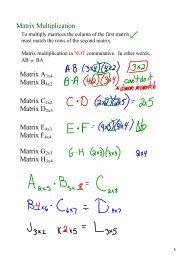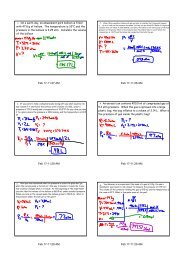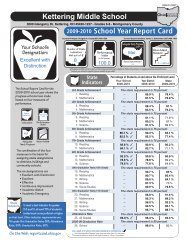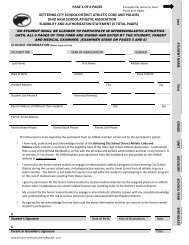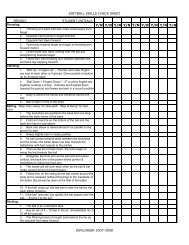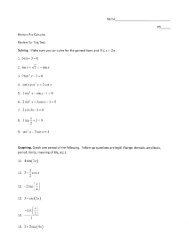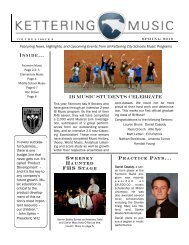You also want an ePaper? Increase the reach of your titles
YUMPU automatically turns print PDFs into web optimized ePapers that Google loves.
Name Class Date<br />
Assessment<br />
<strong>Chapter</strong> <strong>Test</strong> A<br />
<strong>Chapter</strong>: States of Matter<br />
In the space provided, write the letter of the term or phrase that best completes each<br />
statement or best answers each question.<br />
______<br />
______<br />
______<br />
______<br />
______<br />
1. The kinetic-molecular theory of gases assumes that the particles of an<br />
ideal gas are separated by great distances. This implies that the gas<br />
particles are considered to have no definite<br />
a. mass.<br />
b. volume.<br />
c. density.<br />
d. energy.<br />
2. Under which conditions does a real gas behave very much like an ideal<br />
gas?<br />
a. high temperature and low pressure<br />
b. high temperature and high pressure<br />
c. low temperature and high pressure<br />
d. low temperature and low pressure<br />
3. If a gas and a liquid are at the same temperature and pressure,<br />
diffusion occurs much faster in the gas because<br />
a. there are more elastic collisions between the particles in a gas.<br />
b. gases are more compressible.<br />
c. the particles move faster in a gas and there is a greater distance<br />
between them.<br />
d. gas molecules are in continuous motion.<br />
4. If the particles in a sample of matter are attracted to each other but<br />
can move past each other easily, the matter is a<br />
a. solid.<br />
b. liquid.<br />
c. gas.<br />
d. plasma.<br />
5. According to the equation for the kinetic energy of a moving object,<br />
which gas would have the lowest average velocity, assuming all gases<br />
are at the same temperature?<br />
a. O 2<br />
b. H 2<br />
c. H 2 O<br />
d. O 3<br />
Copyright © by Holt, Rinehart and Winston. All rights reserved.<br />
Modern Chemistry 84 <strong>Chapter</strong> <strong>Test</strong>
Name Class Date<br />
<strong>Chapter</strong> <strong>Test</strong> A, continued<br />
______<br />
______<br />
______<br />
______<br />
6. Which factor is the most important in determining the average kinetic<br />
energy of gas particles?<br />
a. pressure<br />
b. temperature<br />
c. volume of the container<br />
d. mass of the container<br />
7. Which gas is most likely to deviate from ideal gas behavior?<br />
a. Ne<br />
b. CO 2<br />
c. NH 3<br />
d. H 2<br />
8. What is likely to happen to a liquid mixture of water and rubbing<br />
alcohol in an open flask as temperature is increased while pressure<br />
stays the same?<br />
a. Both liquids will vaporize at the same rate.<br />
b. Water will vaporize faster.<br />
c. Vaporization and condensation will reach equilibrium.<br />
d. Rubbing alcohol will vaporize faster.<br />
9. Sublimation involves changing from a<br />
a. solid to a gas.<br />
b. liquid to a gas.<br />
c. gas to a liquid.<br />
d. gas to a solid.<br />
______10. Which characteristic accounts for the fluidity of gases and liquids?<br />
a. strong intermolecular forces<br />
b. elastic collisions between particles<br />
c. particle mobility<br />
d. small particle size<br />
______11. Liquids and solids are much denser than gases because the<br />
particles of liquids and solids have a<br />
a. greater mass.<br />
b. closer arrangement.<br />
c. greater volume.<br />
d. smaller volume.<br />
______12. An increase in pressure exerted on a liquid does not compress the<br />
liquid as much as the same increase in pressure compresses a gas<br />
because<br />
a. particles are more closely packed in liquids.<br />
b. liquids transmit pressure in all directions.<br />
c. intermolecular forces are stronger in liquids.<br />
d. particles in liquids are in constant movement.<br />
Copyright © by Holt, Rinehart and Winston. All rights reserved.<br />
Modern Chemistry 85 <strong>Chapter</strong> <strong>Test</strong>
Name Class Date<br />
<strong>Chapter</strong> <strong>Test</strong> A, continued<br />
______13. The separation process of paper chromatography can be explained by<br />
a. vaporization of the ink.<br />
b. water vapor pressure.<br />
c. capillary action.<br />
d. pull of gravity.<br />
______14. When there is a small decrease in temperature, the average kinetic<br />
energy of the particles of a liquid<br />
a. decreases.<br />
b. becomes zero.<br />
c. is not changed.<br />
d. increases.<br />
______15. The movements of particles in solids can best be described as<br />
a. from point to point.<br />
b. vibrational.<br />
c. not in motion.<br />
d. like a lattice.<br />
______16. Amorphous solids behave like liquids at certain temperatures because<br />
of their<br />
a. particle fluidity.<br />
b. incompressibility.<br />
c. high density.<br />
d. random arrangement.<br />
______ 17. Covalent molecular crystals have very low melting points, while<br />
covalent network crystals have very high melting points because<br />
a. the forces that hold molecules together in molecular crystals are<br />
weaker than those that hold molecules or atoms together in<br />
network crystals.<br />
b. there are more molecules in molecular crystals than in network<br />
crystals.<br />
c. network crystals are more intricate crystals.<br />
d. molecular crystals can be either polar or nonpolar, while network<br />
crystals are always nonpolar.<br />
______18. Which of the following is true for the melting and freezing points of a<br />
pure substance?<br />
a. The melting point is higher than the freezing point.<br />
b. The melting point is lower than the freezing point.<br />
c. The melting point is the same as the freezing point.<br />
d. There is no relationship between the freezing point and the melting<br />
point.<br />
Copyright © by Holt, Rinehart and Winston. All rights reserved.<br />
Modern Chemistry 86 <strong>Chapter</strong> <strong>Test</strong>
Name Class Date<br />
<strong>Chapter</strong> <strong>Test</strong> A, continued<br />
______19. In general, ionic compounds have<br />
a. high boiling points and low melting points.<br />
b. low boiling points and high melting points.<br />
c. high boiling points and high melting points.<br />
d. low boiling points and low melting points.<br />
______20. Water has an unusually high molar enthalpy of vaporization because<br />
of its<br />
a. covalent nature.<br />
b. hydrogen bonding.<br />
c. ionic interactions.<br />
d. polar nature.<br />
______21. A solid’s molar enthalpy of fusion is the energy that is<br />
a. released when a solid melts.<br />
b. absorbed when a solid melts.<br />
c. needed to transform a solid to a gas.<br />
d. required for equilibrium.<br />
______22. One mole of benzene vapor condenses at its boiling point. The amount<br />
of energy released by the benzene as it completely condenses is<br />
known as its molar<br />
a. enthalpy of fusion.<br />
b. enthalpy of vaporization.<br />
c. entropy of fusion.<br />
d. entropy of vaporization.<br />
______23. A sample of carbon dioxide gas is in equilibrium with solid dry ice. If<br />
the temperature of the system increases,<br />
a. vapor pressure increases.<br />
b. vapor pressure decreases.<br />
c. more dry ice forms.<br />
d. carbon dioxide gas condenses.<br />
______24. A phase diagram relates the state of matter, pressure, and<br />
a. temperature.<br />
b. volume.<br />
c. mass.<br />
d. weight.<br />
______25. On a phase diagram, the point at which all equilibrium lines join is the<br />
a. melting point.<br />
b. boiling point.<br />
c. critical point.<br />
d. triple point.<br />
Copyright © by Holt, Rinehart and Winston. All rights reserved.<br />
Modern Chemistry 87 <strong>Chapter</strong> <strong>Test</strong>




